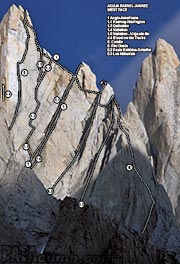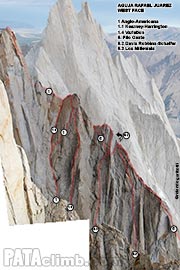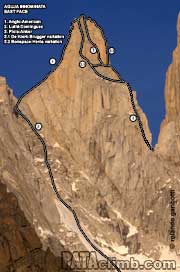Aguja Rafael Juarez- West face
1. Anglo-Americana
1.1 Kearney-Harrington
1.2 Variante directa
1.3 Quilombo
1.4 Variante espolón
1.5 Variante - Viaje sin fin
400 m 6c (6b+ A0)
Rick Silvester, Dan Reid (US), Paul ‘Tut’ Braithwaite, Martin Boysen and Leo Dickinson (GB), 1974.
The route starts up a big dihedral that slashes across the west face, but after three pitches traverses right following a line of weakness to the right of the dihedral, to reach a shoulder (5+). From here it follows the south ridge with easy climbing at first, followed by a flake system (6a+) to then traverse left to reach the west face (6b). The second to last pitch is a difficult wide crack (bring one camalot 4) followed by a steep overlap (6c) to reach a saddle between the two summits. To get to the rapels bypass the southern summit on its east side. Of the 13 or so pitches that the route involves only the last two are worth much.
Variante directa - 1.2. From the top of the flake system two pitches below the top. and instead of traversing left, one can continue up a steep crack that goes directly to the summit (6b). This variation is the preffered route.
Variante espolón - 1.4. At the start of the route, climb the obvious ridge to the right rather than up the dihedral. Six to seven pitches with difficulties to 6a.
History. Because the first ascent party lacked bongs Martin Boysen had to climb the crux wide crack free and without protection... Regarding that exciting moment Dickinson later wrote: “Reid came to a vertical crack that looked as if it needed bongs. We had none and so Boysen climbed it free at what he thought to be good Welsh extreme standard and in boots. He climbed it with one boot and one hand in the crack with his other limbs lashing along the edge of the crack. He thought he was off a few times before he reached the top of the crack and when he did, he was so exhausted that he could not belay for five minutes”. Paul Braithwaite had broken his arm not long before during an attempt on Torre Egger, so he climbed the route with his arm in a cast... They made the ascent in two days, bivouaquing in a small ledge ten meters below the summit.
Solo ascent. In 2/2007 Chilean Jimmy Mora did the first solo ascent of the route, the second solo ascent of the tower after Jon Walsh's solo of Como no! Colin Haley did the second solo ascent of the route in 12/2011. In 3/2019, Jim Reynolds free-solo downclimbed this route, having free-soloed up the Filo Oeste.
Winter ascent. In the early 1990s Basques Willy Bañales and Javi Mugarra (ES) climbed to three pitches from the summit.
Approach. Polacos.
Descent. Down the south ridge first, via variation 1.2, then via the same route.
Bibliography. Mountain 37 p. 11; Mountain 38 p. 31; AAJ 1975 p. 184-188. |
Photos (click to enlarge)
 Aguja Rafael Juarez west face

Aguja Rafael Juarez west face  Aguja Rafael Juarez west face 
Aguja Rafael Juarez east face  Aguja Rafael Juarez south face |
1.1 Kearney-Harrington
Alan Kearney and Sue Harrington (US), 29-30/1/1988.
Climb the first three pitches of the Anglo-Americana then continue straight up, climbing the crack in the big dihedral. This 150-meter variation offers very high quality climbing, although some of it involves wide cracks (6b+). Kearney and Harrington, just as the first ascensionists, underestimated the size of the peak and were forced to an unplanned bivy.
Bibliography. AAJ 1989 p.176, p. 178; Climbing Magazine 110 p. 72-76.
|
1.3 Quilombo
250m 7a C1
Zack Smith and Heidi Wirtz (US), 30/1/2004.
This route starts at the base of the Anglo-Americana dihedral to then head left onto the steep west face, along various right leaning cracks, with two short face sections heading ledt linking obvious crack systems. It offers sustained climbing, with four pitches harder than 6c, one of which, right before the ridge involves some aid, one of 6b and three of 6a. After these eight pitches the route joins the Anglo-Americana for four more pitches to the summit (400m altogether).
Variante - Viaje sin fin. Three pitches below the ridge instead of heading right continue straight. Ryo & Sayaka Masumoto (JP), 1/2019.
History. Heidi and Zach christened the route “Quilombo,” an Argentine slang word meaning “total mess”. They chose this name because they got to the top in horrible looking weather and Heidi's hand got tweaked somewhere along the way, leaving her laid up for the remainder of their trip.
Gear. Doubles to 2, one ea. to #5, TCUs, Stoppers. |




